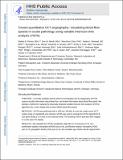| dc.contributor.author | Ploner, Stefan B | |
| dc.contributor.author | Moult, Eric Michael | |
| dc.contributor.author | Choi, WooJhon | |
| dc.contributor.author | Lee, ByungKun | |
| dc.contributor.author | Potsaid, Benjamin M. | |
| dc.contributor.author | Schottenhamml, Julia Jennifer | |
| dc.contributor.author | Fujimoto, James G | |
| dc.date.accessioned | 2021-02-03T18:54:38Z | |
| dc.date.available | 2021-02-03T18:54:38Z | |
| dc.date.issued | 2016-12 | |
| dc.identifier.issn | 0275-004X | |
| dc.identifier.uri | https://hdl.handle.net/1721.1/129651 | |
| dc.description.abstract | Purpose: Currently available optical coherence tomography angiography systems provide information about blood flux but only limited information about blood flow speed. The authors develop a method for mapping the previously proposed variable interscan time analysis (VISTA) algorithm into a color display that encodes relative blood flow speed. Methods: Optical coherence tomography angiography was performed with a 1,050 nm, 400 kHz A-scan rate, swept source optical coherence tomography system using a 5 repeated B-scan protocol. Variable interscan time analysis was used to compute the optical coherence tomography angiography signal from B-scan pairs having 1.5 millisecond and 3.0 milliseconds interscan times. The resulting VISTA data were then mapped to a color space for display. Results: The authors evaluated the VISTA visualization algorithm in normal eyes (n = 2), nonproliferative diabetic retinopathy eyes (n = 6), proliferative diabetic retinopathy eyes (n = 3), geographic atrophy eyes (n = 4), and exudative age-related macular degeneration eyes (n = 2). All eyes showed blood flow speed variations, and all eyes with pathology showed abnormal blood flow speeds compared with controls. Conclusion: The authors developed a novel method for mapping VISTA into a color display, allowing visualization of relative blood flow speeds. The method was found useful, in a small case series, for visualizing blood flow speeds in a variety of ocular diseases and serves as a step toward quantitative optical coherence tomography angiography. | en_US |
| dc.description.sponsorship | National Institutes of Health (U.S.) (Grants (NIH R01-EY011289-29A, R44-EY022864, R01-CA075289-16, FA9550-15-1-0473 and FA9550-12-1-0499) | en_US |
| dc.language.iso | en | |
| dc.publisher | Ovid Technologies (Wolters Kluwer Health) | en_US |
| dc.relation.isversionof | 10.1097/IAE.0000000000001328 | en_US |
| dc.rights | Creative Commons Attribution-Noncommercial-Share Alike | en_US |
| dc.rights.uri | http://creativecommons.org/licenses/by-nc-sa/4.0/ | en_US |
| dc.source | PMC | en_US |
| dc.title | TOWARD QUANTITATIVE OPTICAL COHERENCE TOMOGRAPHY ANGIOGRAPHY: Visualizing Blood Flow Speeds in Ocular Pathology Using Variable Interscan Time Analysis | en_US |
| dc.title.alternative | Toward quantitative OCT angiography: visualizing blood flow speeds in ocular pathology using variable interscan time analysis (VISTA) | en_US |
| dc.type | Article | en_US |
| dc.identifier.citation | Ploner, Stefan B. et al. “Toward quantitative OCT angiography: visualizing blood flow speeds in ocular pathology using variable interscan time analysis (VISTA).” Retina, 36 (Suppl 1), 12 (December 2016): S118–S126 © 2016 The Author(s) | en_US |
| dc.contributor.department | Massachusetts Institute of Technology. Research Laboratory of Electronics | en_US |
| dc.contributor.department | Massachusetts Institute of Technology. Institute for Medical Engineering & Science | en_US |
| dc.contributor.department | Massachusetts Institute of Technology. Department of Electrical Engineering and Computer Science | en_US |
| dc.relation.journal | Retina | en_US |
| dc.eprint.version | Author's final manuscript | en_US |
| dc.type.uri | http://purl.org/eprint/type/JournalArticle | en_US |
| eprint.status | http://purl.org/eprint/status/PeerReviewed | en_US |
| dc.date.updated | 2020-12-11T19:36:50Z | |
| dspace.orderedauthors | Ploner, SB; Moult, EM; Choi, W; Waheed, NK; Lee, B; Novais, EA; Cole, ED; Potsaid, B; Husvogt, L; Schottenhamml, J; Maier, A; Rosenfeld, PJ; Duker, JS; Hornegger, J; Fujimoto, JG | en_US |
| dspace.date.submission | 2020-12-11T19:36:57Z | |
| mit.journal.volume | 36 | en_US |
| mit.journal.issue | 12 | en_US |
| mit.license | OPEN_ACCESS_POLICY | |
| mit.metadata.status | Complete | |
